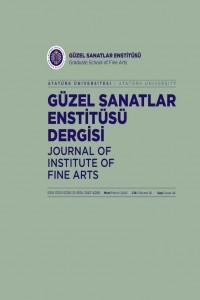Yinelenen Bir Tema: Yirmibirinci Yüzyılın İkinci On Yılının Başında "Fotoğrafik Tasarım"
Walter Benjamin’in yeniden üretilebilirlik çağındaki sanat eserleri üzerine yazdığı makale, beşeri bilimler çalışmalarında en çok alıntı yapılan denemelerden birisidir. Bu makale de, Benjamin’in yirminci yüzyılda aura’nın çürümesi yolunda ileri sürdüğü iddia, başka bir öncü olan Laszlo Moholy-Nagy’nin erken dönem fotografik montaj çalışmaları aracılığıyla kurtarılabileceği iddia edilecek ve ‘fotografik tasarım’ adlı kavramsal bir çerçeve tasvir edilecektir. Bu iddia akılda tutularak, bu makale aynı zamanda yirminci yüzyıl sanat eserlerindeki aura kaybını neoliberal politikanın mevcut durumu ve tasarımla olan ilişkisiyle ilişkilendirmekte ve böylece güncel post-endüstriyel teorisyenlerin çalışmalarıyla da bağlantı kurmaktadır.
Anahtar Kelimeler:
Walter Benjamin, Laszlo moholy-Nagy, Paul Virilio, Neoliberalizm, Politik Tasarım, Fotoğrafik Tasarım
A Recurring Theme: ‘Photographic Design’ at The Beginning of The Second Decade of Twenty-First Century
Walter Benjamin’s essay on artworks in the age of their reproducibility is one of the most cited essays in humanities study. In this study, it will be claimed that Benjamin’s claim for the rotting of aura in the twentieth century can be salvaged through another pioneer Laszlo Moholy-Nagy’s early photographic assemblage works, and a conceptual framework named ‘photographic design’ will be depicted. With this claim in mind, this essay also relates the twentieth century’s artworks’ loss of aura with the current status of neoliberal politics and its relationship with design and thus engages with current post-industrial theorists’ works as well.
Keywords:
Walter Benjamin, Laszlo Moholy-Nagy, Paul Virilio, Neoliberalism, Political design, Photographic design,
___
Armitage, J. (Ed.). (2000). Paul Virilio: from Modernism to Hypermodernism and beyond. London: Sage.Benjamin, W. (1974). Das kunstwerk im zeitalter seiner technischen reproduzierbarkeit. R. Tiedemann & H. Schweppenhäuser (Ed.), Gesammelte schriften bd. 1 (s. 471-508) içinde. Frankfurt am Main: Suhrkamp.
Benjamin, W. (2003). The work of art in the age of its technological reproducibility. M. W. Jennings (Ed.), In selected writings volume 4 (p. 251–83). Cambridge, MA: Belknap.
Bourdieu, P. (1991). Language and symbolic power. Cambridge, MA: Harvard University Press.
Botar, O. (2003). Biocentrism and the Bauhaus. The Structurist, 43-44, 54-61. Access address: https://www.academia.edu/38876065/BIOCENTRISM_AND_THE_BAUHAUS?auto=download
Callon, M. & Law, J. (2005). On qualculation, agency and otherness. Environment and Planning D: Society and Space, 23(5), 717–733. doi: https://doi.org/10.1068/d343t
Cochoy, F. (2008). Calculation, qualculation, calqulation: Shopping cart arithmetic, equipped cognition and the clustered consumer. Marketing Theory, 8(1), 15-44. doi: https://doi.org/10.1177/1470593107086483
Comaroff, J. L. (1989). The colonization of consciousness in South Africa. Economy and Society, 18(3), 267-95. doi: https://doi.org/10.1080/03085148900000013
Crary, J. (1992). On technics of the observer: On vision and modernity in Nineteenth Century. Cambridge, MA: MIT Press.
Dreyfus, H. L. (2002). On the internet. London and New York: Routledge.
Duttlinger, C. (2008). Imaginary encounters: Walter Benjamin and the aura of photography. Poetics Today, 29(1), 79-101. doi: https://doi.org/10.1215/03335372-2007-018
Folkmann, M. N. (2013). The aesthetics of imagination in design. Cambridge, MA: MIT Press.
Foucault, M. (1980). Power/knowledge: Selected interviews and other writings 1972–1977. C. Gordon (Ed.), New York: Pantheon Books.
Hansen, M. (1987). Benjamin, cinema, and experience: The blue flower in the land of technology. New German Critique, 40, 179–224. doi: https://doi.org/10.2307/488138
Horak, J. C. (1997). Making images move: Photographers and avant-garde cinema. Washington, DC: Smithsonian Institution Press.
Julier, G. (2017). Economies of design. UK: Sage Publications.
Leach, N. (2000). Virilio and architecture. J. Armitage (Ed.), In Paul Virilio: From Modernism to Hypermodernism and Beyond (p. 71-84). London: Sage.
Lury, C. (2004). Brands: The Logos of the Global Economy. Abingdon: Routledge.
Manovich, L. (2000). The language of new media. Cambridge: MIT Press.
Milestone, J. (2007). Design as power: Paul Virilio and the governmentality of design expertise. Culture, Theory & Critique, 48(2), 175-198. doi: https://doi.org/10.1080/14735780701723264
Moholy Nagy, L. (1969). Painting, photography film. (J. Seligman, Çev.). London: Lund Humphries.
Moholy Nagy, L. (1990). Die photographie in der reklame. C. Phillips, (Ed.), In photography in the modern era: European documents and critical writings. New York: Metropolitan Museum of Art.
Nelson, A. (2006). László Moholy-Nagy and painting, photography, film: A guide to narrative montage. History of Photography, 30(3), 258-269. doi: https://doi.org/10.1080/03087298.2006.10443468
Otero Pailos, J. (2000). Living or leaving the techno-apocalypse: Paul Virilio’s critique of technology and its contribution to architecture. Journal of Architectural Education, 54(2), 104–110. doi: https://doi.org/10.1162/104648800564815
Roxburgh, M. (2008). “Photographic Design”, Design Dictionary, M. Erlhoff and T. Marshall (Ed.), (s. 296-8). Basel: Verlag Birkhäuser.
Thrift, N. (2005). Knowing Capitalism. London: Sage.
Thrift, N. (2008). Non-representational Theory: Space, Politics, Affect. Abingdon, Oxon: Routledge.
Virilio, P. (1992). Big optics. P. Weibel (Ed.), In on justifying the hypothetical nature of art (p. 82-93). Cologne: Walther Konig.
Winograd, T., & Flores F. (1986). Understanding computers and cognition: A new foundation for design. London: Intellect Books.
- ISSN: 1300-9206
- Yayın Aralığı: Aylık
- Yayıncı: Atatürk Üniversitesi
Sayıdaki Diğer Makaleler
Şehbâl Mecmuasında Yer Alan Kadınlara Ait Giysi Önerileri
Keziban SELÇUK, Hüseyin YURTTAŞ
Grafik Tasarım Öğretiminde Yeni Yöntem Arayışı
Changing Lanes Filmiyle Stoa Felsefesini Yeniden Düşünmek: “Apatheia” Durumuna Ulaşmak
Gerit Grimm ve Seramik Tornasında Şekillendirilmiş Figüratif Heykelleri
Disiplinlerarası Atölye Çalışmalarına Bir Örnek: Baskıresim-Seramik Yakınlaşmaları
Duygu ULUSOY YILMAZ, Didem AKAR
